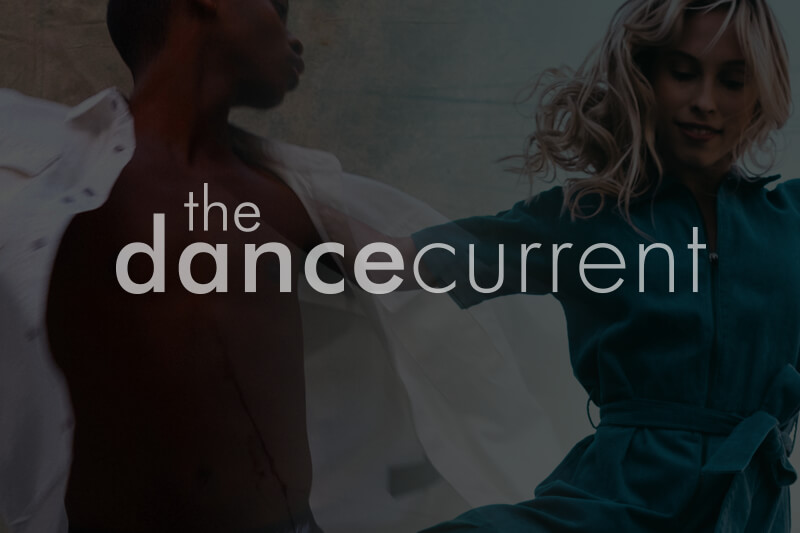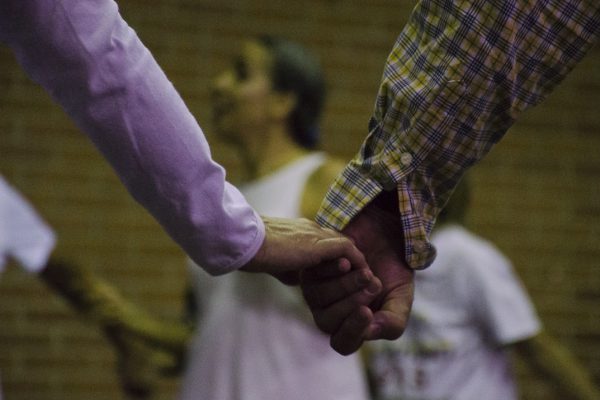As a contemporary choreographer and dancer, I am interested in creative approaches that combine set parameters with spontaneous choice. Diverse methods rooted in African dance techniques and social dancing, as well as many of the somatic approaches increasingly used across the globe, inspire me in the studio as I work. As a dancer who has performed with numerous companies, I have been directed in a range of contexts and observed that no matter how a choreographer may define their work, improvisational or not, most would agree that the dancer being in the present moment is essential for delivering a piece to an audience.
In fall 2012, my interest in going deeper into a practice of mixing set choreography with improvisation was funnelled into research sessions with dancer/Assistant Professor Johanna Bienaise of the Départment de Danse de l’Université du Québec à Montréal and composer/Associate Professor Owen Chapman of the Communications Department at Concordia University. In our research we practised improvisational techniques for finding spontaneous precision and clarity in various relationships to time. We examined task-oriented methods for creating dance with the senses, with objects and with rhythm. Our methods were inspired by exercises taught to me by original Judson Church artist Lisa Nelson, dance artist Sarah Shelton Mann of Company Contraband fame and fundamental African dance techniques I have learned from dance artist Zab Maboungou of Companie Danse Nyata Nyata.
As I look back on this research and how it fits into the contemporary dance landscape of Canada and based on my observations over the past fifteen years, it seems that in most professional training programs improvisational and somatic techniques are under-represented in comparison to ones that rely on replicating the form and movement of the teacher. Could this really be true in 2013?
Recently I spoke with internationally renowned Canadian teacher Andrew de Lotbinière Harwood on the subject and asked him exactly that. Here’s what he said: “Much to my own dismay, you are correct in saying that improvisation is undervalued in most of the training that young dance professionals receive in Canada. Most training programs are perhaps behind the times and do not yet recognize the implicit value of the various approaches to improvisational techniques, aesthetics and forms which feed directly into preparing young students for the worldwide market as dancers, creators, directors. Yet it is also encouraging to note that this training is filtering through various local institutions especially in Montreal and Vancouver, and to a lesser degree Winnipeg, Edmonton and Toronto.”
It does seem that improvisation is taught or at least done periodically in classes as part of some programs, but somatic techniques–and there are many, including David Zambrano’s Flying Low, Ohad Nahrin’s Gaga technique, Authentic Movement, developed by Mary Starks Whitehouse in the 1950s, and numerous others–are not rigorously taught in most curricula as essential techniques for students entering the professional field.
This is despite the fact that an overwhelming number of successful companies and independent artists around the world, including many in Canada, rely heavily on these types of techniques in the studio and onstage. What is certain is that improvisation in Canada is often seen as a purely creative activity rather than a rigorous technical practice. This leads me to wonder how more legitimacy can be brought to improvisational and somatic techniques inside Canada – not only in the academy but also in dialogues with collaborators, audiences and presenters.
The effectiveness of inviting elements of improvisation, even in small amounts, into live performance has contributed to the success of many acclaimed companies including Companie Marie Chouinard, Batsheva Danse, Damaged Goods and the work of William Forsythe, to name just a few. In the professional context it is increasingly common for choreographers to combine set parameters with preplanned choice in performance. The set parameter could be an aesthetic or intellectual framework, a movement vocabulary, a cultural reference, set choreography, interaction with an object, or something task-oriented. Choice may come by way of a series of options for spontaneous remixing by the performer or from the rules of an invented game, play with qualities, or even sound events that trigger instant adaptation. The number and nature of these choices varies greatly and exact recipes for these combinations of set and improvised performance also varies among artists.
Many dancers are attracted to improvisation within the framework of a structured piece with a clear vocabulary of movement. Improvisation offers freedom of choice and more responsibility as a result – it can be a way to move away from archaic ideas of the dancer as solely an abstract, mute object, or raw material for the choreographer to blow life into. As the milieu does not automatically credit dancers as “collaborators” and therefore diminishes their artistic practice, the inclusion of improvisation in a project can also be a way to highlight the dance’s creative practice. To not acknowledge that dancers are collaborators (whether they improvise or not) is deeply problematic at best and, at worst, outright deceptive.
In live performance nothing is ever completely known; controlling how all things unfold is impossible. Conversely, nothing is ever completely unknown in an improvisation; there is always at least a context or an artistic practice that predetermines content and aesthetics. I have found that engaging performance is more about the artists on stage knowing what they are doing in great detail, and less about whether or not it is completely choreographed or improvised. In fact the terms “improvisation” and “set choreography” seem increasingly irrelevant in both professional and academic discourses outside of Canada. So why not here? It seems that many Canadian professional training programs would do a service to their students by reflecting this in their curricula.
Considerations for all the aspects of live performance (space, time, the body in all its complexities, dramaturgy, proximity, contexts of venue, sound, images, light, costume, ideas and so on) yield the best outcomes on stage and in the studio. These considerations can happen slowly over time in the creative process and/or instantly in front of the public. The result is the same: clear artistic propositions. Talented artists know how, or can be guided to know how, to approach the unknown nature of a live event and there are many established methods for doing so.
Combining spontaneous choice with precision, intention and knowledge of what spaces are being created by the dance, is a great way to invite the sort of happy accidents that make performance exciting. Mixing set and improvised material has yielded countless wonderful works on the international stage. Performers embracing elements of the unknown with focus, empowerment and humility is at the heart of the most profound performances I have witnessed.
Recently I had the pleasure to be at one such performance. It was AH HA Productions’ Discovery Bal, presented at l’Agora de la Danse on January 12, 2013. Discovery Bal is an improvised piece danced by Peter Bingham, Andrew de Lotbinière Harwood (who is also the Artistic Director of AH HA), Marc Boivin and Chris Aiken, with live music performed by Diane Labrosse and Pierre Tanguay. The performers were clear, dynamic, direct, and at times disarmingly vulnerable. It was an example of a seasoned group of masters at work.
Continuing to take note and expand on the approaches of pioneers such as Peter Bingham, Andrew de Lotbinière Harwood, Zab Maboungou, Lisa Nelson, Sarah Shelton Mann and many others is important for the advancement of the contemporary dance profession in Canada. Choreographing and dancing with improvisational techniques is an essential way to invite innovative choreographies to emerge, keep practices truly contemporary and produce great performances.
Tagged: Contemporary, Discourse, Improvisation, All , Montréal




